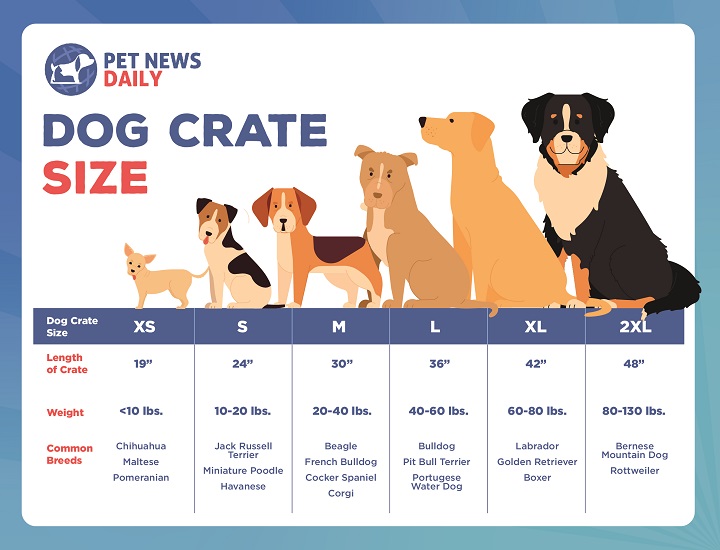A dog crate may seem like a nonessential pet-care item or a form of punishment, but dog crates can be an important part of your dog’s life. From soft to hard, plain to decorative, and practical to over-the-top, dog kennels and crates come in sizes appropriate for just about any pup. Whether you’re house training or traveling by car or air, a crate or kennel can be a safe and cozy containment for your pooch.
We consulted our veterinarian, Dr. Jennifer Coates, about the best dog crate size you should get your dog. After Dr. Coates reviewed and approved the data, we created a dog crate size chart for your convenience. Whether you’re the caregiver of a Chihuahua, Beagle, Boxer, or Bernese Mountain Dog, our chart provides the information you need to choose the size of your dog crate wisely.
In This Article
Dog Crate Size Chart
To find out which sized crate you may need based on your dog’s breed or weight, check out our custom and comprehensive dog crate size chart below.
Share This Dog Crate Size Chart on Your Site
Text Transcript of Dog Crate Size Chart
| Dog Crate Sizes | Length of Crate | Weight | Common Breeds |
|---|---|---|---|
| XS S M L XL 2XL |
19″ 24″ 30″ 36″ 42″ 48″ |
<10 lbs. 10 – 20 lbs. 20 – 40 lbs. 40 – 60 lbs. 60 – 80 lbs. 80 – 130 lbs. |
Chihuahua, Maltese, Pomeranian Jack Russell Terrier, Miniature Poodle, Havanese Cocker Spaniel, French Bulldog, Beagle, Corgi Bulldog, Pit Bull Terrier, Portuguese Water Dog Lab, Golden Retriever, Boxer Rottweiler, Bernese Mountain Dog |
Reasons to Use a Dog Crate
Dog crates are an investment in your dog’s well-being. Regardless of how your pooch comes into your life – as a brand new puppy, young adult, or older senior, dog crates serve multiple uses. Use a dog crate for:
- House training
- Behavioral training
- Travel
- Emergencies
- Rest from injury or surgery
- Private hideaway
Dog crates come in handy for house training; most dogs don’t like to soil the area where they sleep, which encourages them to hold their bladder. Fearful or destructive dogs also benefit from a crate – it provides a place to retreat, regroup, and stay safe. It’s animal instinct to find a small, hidden spot to rest, away from predators, positioned so their back is protected and there’s not much to surveil. For this reason as well, crates give your dog a safe and secure place to recover from an injury or surgery, when remaining relatively immobile is crucial to healing.1
No matter what your reason is for using a dog crate or kennel, getting your pup used to one as soon as possible is highly recommended. Not all dogs will like a crate, but if for no other reason, emergencies often warrant the use of a crate. Whether for evacuation and safe travels or recovery from injury, an emergency is not the way to first introduce your dog to a crate or kennel. It should signify a safe, comforting place, not a scary one.
Types of Dog Crates or Kennels
With so many types of dog crates or kennels (from large heavy duty dog crates to outdoor dog kennels to indoor dog houses) to choose from, how do you know which one to pick? Each type of crate serves a different purpose.
- Plastic dog crates are typically used to transport dogs, whether by car or plane. They often feature a hard, vented shell with one door. A carry handle sits on top for easier transportation. Plastic dog crate sizes are varied, though, and crates come in different colors, patterns, and designs.
- Wire or metal dog crates look like grid fencing on all sides, which allows for unrestricted airflow. These crates generally fold flat for easy storage and portability. They feature a hard plastic bottom tray. A wire crate is frequently used in homes, rescues, shelters, and outdoor areas.
- End table dog crates, or furniture dog crates, double as decoration for your home. These crates are often made of wood and are stylish and typically more expensive. End table dog crates are better for dogs who have already been crate-trained and are comfortable hanging out in useable furniture.
- Soft dog crates are made out of a soft, pliable material, such as nylon or canvas, and are often used for travel with small dogs. They’re portable and store well. A soft dog crate usually features flexible sides that zip or tie open and shut, creating closed, solid sides or open, breathable, mesh sides.
- Heavy-duty dog crates are constructed from strong materials such as steel and aluminum for tough durability. Used most often for travel due to high crash-test ratings, heavy-duty dog crates can literally be a doggie lifesaver.2
What Size Dog Crate Do I Need?
So how do you know how big a dog crate should be? Dog crates come in all sizes for all types of breeds, and it can depend on what you’re using the crate for. Puppies require smaller crates than adult dogs, and some companies offer crates that “grow” with your puppy – by providing dividers you can add or remove to adjust the size of the area inside the crate.
If you’re house training, you don’t want the crate to be overly large, but if your pooch is already accustomed to hanging out in a crate, she might appreciate ample space. For travel, use a dog travel crate that’s big enough for your pooch but also fits in your car or on the plane according to the airline’s specifications.
How to Measure Your Dog for a Travel Crate
To determine how much room a dog should have in a crate, we consulted our veterinarian, Dr. Coates. She advised, “a crate should be several inches longer than a dog’s body length (minus their tail) to ensure comfort.” In order to figure that out, measure your dog from the tip of his nose to the base of his tail, along his side. The most convenient time to do this is when he’s already lying down stretched out. How he normally spreads out gives you a better idea of what size the crate should be.
Crate Training Your Dog
Crate training a puppy or dog should be a positive experience resulting in a positive outcome – you want your dog to love her crate. Not all dogs will, of course, but teaching your pooch the crate is rewarding is the first step. Train her early so she understands it’s her safe place, time away, and cozy den. Create a positive association with the crate using treats, toys, and familiar comforts. This gives your dog security, ownership, and helps build confidence.34
Create a welcoming and calming environment inside the crate. This can look different for each dog, and the atmosphere you create can depend on the reason for using the crate in the first place. Even if you’re training your dog for travel, put the crate in a quiet, safe spot away from high-traffic areas to help them acclimate to their new personal space. You may or may not need to cover the top of the crate – wire crates do not feature solid sides or tops, so she doesn’t feel too exposed and vulnerable.
Dog Crate Size by Weight
Though the best way to determine the crate size your dog needs is by measuring your dog, we designed a handy dog crate size chart, broken down by the length of the crate and a dog’s weight group. From extra small to extra, extra large, dog crates are suitable for breeds like Pomeranians, Cocker Spaniels, Labradors, and Rottweilers. For example, a medium dog crate size is typically for medium-size breeds that fall between 20 and 40 pounds. A large dog crate size comfortably shelters medium- to large-size breeds that weigh about 40 to 60 pounds. And an XL dog crate is roughly 42 inches long to accommodate breeds between 60 and 80 pounds.
If you have a growing puppy and you’re not sure how large he’ll be or how much he’ll weigh as an adult, check out our dog size predictor. The calculations are based on the American Kennel Club’s database of adult dog weights and heights. Fill in your puppy’s current age, weight, and other details below. Keep in mind that your dog is an individual, and there are many factors that can impact her weight. Always consult your veterinarian for the best advice on whether your dog is at a healthy weight based on her individual characteristics.
Note: please don’t feed your dog more or less based on the results. For that advice, consult your veterinarian.
PUPPY WEIGHT CALCULATOR
If you’re not sure if your particular breed is done growing as you’re evaluating the best dog crate to buy, we’ve created a series of growth charts to answer questions like: when do goldendoodles stop growing?, when do great danes stop growing?, when do golden retrievers stop growing?, when do chihuahuas stop growing?, and when do labradors stop growing?
Article Sources
Pet News Daily uses only high-quality sources, including peer-reviewed studies, to support the facts within our articles. Read our editorial process to learn more about how we fact-check and keep our content accurate, reliable, and trustworthy.
- Arford K. Crate Training Benefits: Why A Crate Is Great for You and Your Dog. Akc.org. Published November 19, 2019. Accessed February 14, 2022.
- 5 Star Crash Tested. Gunner.com. Accessed February 14, 2022.
- Crate Training 101. Humanesociety.org. Accessed February 14, 2022.
- Sharpe S. How to Crate Train Your Dog in 9 Easy Steps. Akc.org. Published November 5, 2021. Accessed February 14, 2022.


